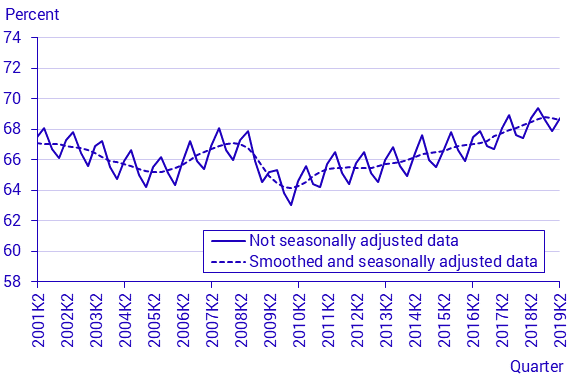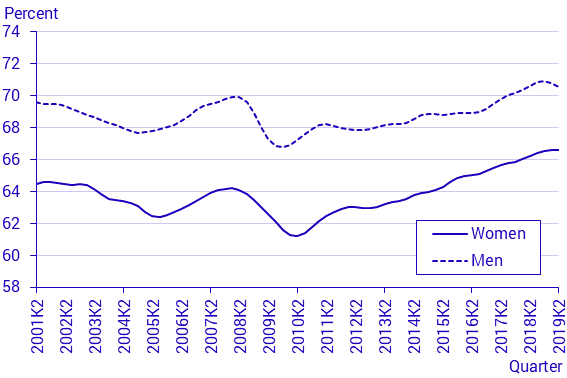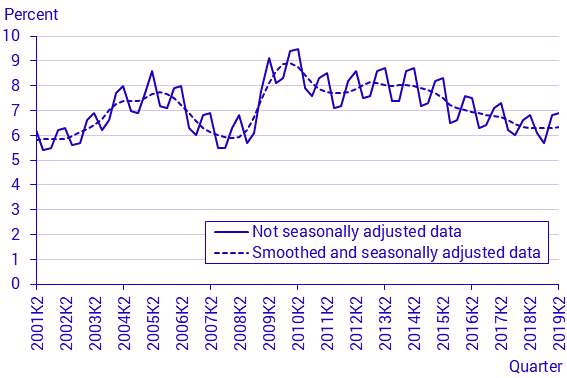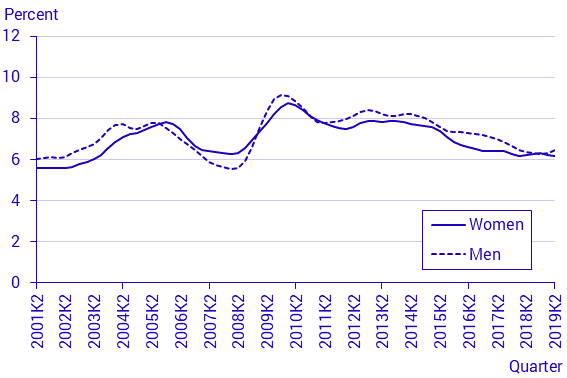Labour Force Surveys (LFS), 2nd quarter 2019
Number of temporary employees decreased
Statistical news from Statistics Sweden 2019-08-27 9.30
The number of employed persons aged 15-74 years increased by 38 000 persons between the second quarter of 2019 and the second quarter of 2018, non-seasonally adjusted, and the unemployment rate was 6.9 percent. The number of hours worked increased by 0.9 percent, calendar adjusted. Smoothed and seasonally adjusted data shows that employment decreased, while the unemployment rate showed a minor change and amounted to 6.3 percent.
The figures in this statistical news release are based on collected data that contains quality deficiencies. Revised LFS figures have been published and are available here:
Labour Force Surveys
The labour force
The number of persons in the labour force aged 15-74 years amounted to 5 542 000 in the second quarter of 2019, non-seasonally adjusted. This is an increase of 46 000 compared to the same quarter of 2018. The number of women in the labour force increased by 22 000 to 2 640 000 and the number of men in the labour force increased by 24 000 to 2 901 000. The relative participation rate was 73.8 percent. Among women, this rate was 71.6 percent and among men it was 76.0 percent.
Seasonally adjusted and smoothed data shows a minor change in the number of persons in the labour force and a decrease in the share of persons in the labour force compared with adjacent quarters. In the second quarter of 2019, there were 5 498 000 persons in the labour force, which corresponds to 73.3 percent of the population.
Employment
In the second quarter of 2019, there were 5 158 000 employed persons aged 15-74 years, non-seasonally adjusted. This is an increase of 38 000 compared to the second quarter of 2018, which corresponds to an employment rate of 68.7 percent. The number of employed women was 2 464 000 and the number of employed men was 2 694 000. The employment rate was 66.8 percent among women and 70.6 percent among men.
Seasonally adjusted and smoothed data shows a minor change in the number of employed persons and a decrease in the share of employed persons compared with adjacent quarters. In the second quarter of 2019, there were 5 150 000 employed persons, which corresponds to an employment rate of 68.6 percent.
Employees
In the second quarter of 2019, there were 4 674 000 employed persons, non-seasonally adjusted, which is an increase of 41 000 persons compared with the corresponding period last year. The number of employed women was 2 329 000 and the number of employed men increased by 25 000 to 2 346 000. The number of permanent employees increased by 71 000 to 3 936 000. The number of permanently employed women increased by 25 000 to 1 914 000 and the number of permanently employed men increased by 46 000 to 2 022 000. The number of temporary employees decreased by 29 000 to 738 000. Among women there were 415 000 temporary employees and among men there were 324 000, a decrease of 21 000.
Seasonally adjusted and smoothed data shows an increase in the number of permanent employees and a decrease in the number of temporary employees.
Hours worked
The total number of hours worked averaged 161.0 million per week, according to non-seasonally adjusted data in the second quarter of 2019. In calendar-adjusted figures, this corresponds to an increase of 0.9 percent compared with the second quarter of 2018.
Seasonally adjusted and smoothed data shows a minor change in the number of hours worked. In the second quarter of 2019, the number of hours worked averaged 157.2 million hours per week.
The majority of employed persons have an agreed working time of 35 hours or more per week, or full-time work. In the second quarter of 2019, there were 4 047 000 persons working full-time, which is an increase of 75 000 persons compared to the same quarter of 2018. The number of men working full-time increased by 24 000 to 2 303 000 and the number of women working full-time increased by 51 000 to 1 744 000. In total, 312 000 persons worked short part-time (1-19 hours), which is a decrease of 21 000 persons. In total 779 000 persons worked long part-time (20-34 hours).
The average actual hours worked among employed persons aged 15-74 years amounted to 31.2 hours per week in the second quarter of 2019. This is a decrease of 0.2 hours compared to the corresponding quarter in 2018. Among women, the number of hours worked was 28.7 hours and among men the number of hours worked decreased by 0.4 hours to 33.5 hours per week.
Underemployment
Among employed persons aged 15-74 years, 210 000 were underemployed in the second quarter of 2019. There were 108 000 underemployed women and 102 000 underemployed men. Underemployed persons accounted for 4.1 percent of employed persons.
Unemployment
In the second quarter of 2019, there were 383 000 unemployed persons aged 15-74 years, non-seasonally adjusted. This corresponds to an unemployment rate of 6.9 percent. There were 176 000 unemployed women and 207 000 unemployed men. The unemployment rate amounted to 6.7 percent among women and 7.1 percent among men.
Among persons aged 15-74 years, the changes in seasonally adjusted and smoothed data were minor in relation to previous quarters. In the second quarter of 2019, there were 348 000 unemployed persons, which corresponds to an unemployment rate of 6.3 percent.
There were 90 000 long-term unemployed persons (who were unemployed for at least 27 weeks) aged 15-74 years in the second quarter of 2019, non-seasonally adjusted. Among men, there were 54 000 and among women there were 36 000.
There were 138 000 unemployed young persons aged 15-24 years, non-seasonally adjusted, which corresponds to an unemployment rate of 21.6 percent. Among unemployed young persons, 73 000 were full-time students.
Among young persons aged 15-24 years, seasonally adjusted and smoothed data shows a decrease in the number of unemployed persons and a minor change in the share of unemployed persons compared with adjacent quarters. There were 105 000 unemployed persons, which corresponds to an unemployment rate of 17.4 percent.
Not in the labour force
The group ’not in the labour force’ includes persons who are not classified as employed nor as unemployed. In the second quarter of 2019, there were 1 963 000 persons not in the labour force. There were 916 000 men and 1 046 000 women in this group.
Among persons not in the labour force, there were 948 000 retired persons. There were 491 000 full-time students, an increase of 47 000 compared with the second quarter of 2018. There were 245 000 persons who reported that they were on long-term sick leave, which is down by 33 000 persons.
Latent job seekers
There were 82 000 latent job seekers aged 15-74 years in the second quarter of 2019. Among young people aged 15-24 years, there were 38 000 latent job seekers.
Unused labour supply
Unemployed persons, underemployed persons and latent job seekers together comprise the unused labour supply. In the second quarter of 2019, the unused labour supply averaged 17.4 million hours per week. The unused labour supply corresponds to 435 000 full-time employments with 40-hour work weeks.
Labour market for persons aged 20-64 years
The population covered by the LFS comprises persons aged 15-74 years. However, labour market participation among younger and older persons in this age group is considerably lower for natural reasons, for example this group contains large shares of students and retired persons. To better approach what can be seen as the core of the actively working population, the situation of the age group 20-64 years is described in the following section.
The relative participation rate among persons aged 20-64 years was 88.1 percent in the second quarter of 2019, non-seasonally adjusted. Among women, the relative participation rate was 85.8 percent and the corresponding figure among men was 90.3 percent. Seasonally adjusted and smoothed data shows a decrease in the participation rate, which amounted to 87.7 percent.
In the second quarter of 2019, the share of employed persons aged 20-64 years was 82.8 percent, non-seasonally adjusted. Among women, the employment rate was 80.9 percent and among men the employment rate was 84.7 percent. Seasonally adjusted and smoothed data shows a decrease in the employment rate, which amounted to 82.7 percent.
According to non-seasonally adjusted data, the unemployment rate in the age group 20-64 years was 6.0 percent. Among women, the unemployment rate was 5.8 percent and among men it was 6.2 percent. In relation to adjacent quarters, seasonally adjusted and smoothed data shows an increase in the share of unemployed persons, which amounted to 5.7 percent.
Swedish born and foreign born persons aged 20-64 years
The relative participation rate among Swedish born persons aged 20-64 years was 89.7 percent in the second quarter of 2019, non-seasonally adjusted. Among Swedish born women, the relative participation rate was 88.4 percent and among Swedish born men it was 91.0 percent. Among foreign born persons aged 20-64 years, the relative participation rate was 83.1 percent in the second quarter of 2019. Among foreign born women, the participation rate was 78.3 percent and among foreign born men it was 88.0 percent. Seasonally adjusted and smoothed data shows a decrease of the participation rate among Swedish born persons and a minor change among foreign born persons. The participation rate amounted to 89.4 percent among Swedish born persons and 82.8 percent among foreign born persons.
In the second quarter of 2019, the share of employed persons among Swedish born persons aged 20-64 years was 86.9 percent, non-seasonally adjusted. Among Swedish born women the employment rate was 85.8 percent and among Swedish born men the employment rate was 87.9 percent. Among foreign born persons, the employment rate was 70.5 percent. Among foreign born men the employment rate was 74.6 percent and among foreign born women it was 66.5 percent. Seasonally adjusted and smoothed data shows a decrease of the employment rate compared with adjacent quarters among both Swedish born and foreign born persons. In the second quarter of 2019, the employment rate was 86.7 percent among Swedish born persons and 70.5 percent among foreign born persons.
The relative unemployment rate among Swedish born persons aged 20-64 years was 3.2 percent in the second quarter of 2019. Among Swedish born women, unemployment amounted to 3.0 percent and among Swedish born men it was 3.4 percent. Unemployment among foreign born persons amounted to 15.1 percent. Among foreign born women, unemployment amounted to 15.0 percent and among foreign born men it was 15.3 percent. According to seasonally adjusted and smoothed data, unemployment increased compared with adjacent quarters and amounted to 3.0 percent among Swedish born persons and 14.8 percent among foreign born persons.




Feel free to use the facts from this statistical news but remember to state Source: Statistics Sweden.
